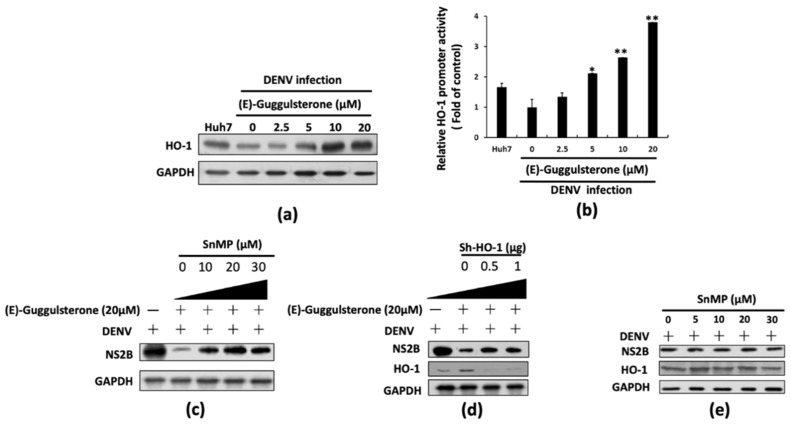Figure 2.
(E)-Guggulsterone inhibits DENV replication through an HO-1 dependent pathway. (a) (E)-guggulsterone enhanced HO-1 protein expression in the DENV-infected cells. DENV-infected Huh-7 cells were treated with the indicated concentrations of (E)-guggulsterone for 3 days, and the HO-1 protein levels were analyzed by Western blotting. (b) (E)-guggulsterone induced the promoter activity. The HO-1 promoter-reporter plasmid, pHO-1-Luc, was transfected into Huh-7 cells. The plasmid-transfected cells were infected with DENV and treated with the indicated concentrations of (E)-guggulsterone (0–20 μM) for 3 days. The cell lysates were then subjected to luciferase activity assay. The relative luciferase activity is presented as fold activation compared to 0.1% DMSO-treated cells (designated as “0”), with DENV infection, defined as “1”. (c,d) Inhibition of HO-1 activity or silencing of HO-1 expression attenuated the inhibitory effect of (E)-guggulsterone on DENV replication. DENV-infected Huh-7 cells were treated with different concentrations of HO-1 inhibitor SnMP (10, 20, 30 μM) or co-transfected with different concentrations of plasmid encoding HO-1 shRNA, pCMV-sh-HO-1, (0.5 and 1 μg) in the absence or presence of (E)-guggulsterone (20 μM) for 3 days. (e) SnMP shows no significant effect on DENV replication and HO-1 expression. DENV-infected Huh-7 cells were treated with different concentrations of SnMP (10, 20, and 30 μM) for 3 days. The DENV and HO-1 protein synthesis was assessed using Western blotting. The treatment with 0.1% DMSO was defined as “0”. The error bars for treatment denote the mean ± SD of three independent experiments (n = 3). * p < 0.05; ** p < 0.01.

